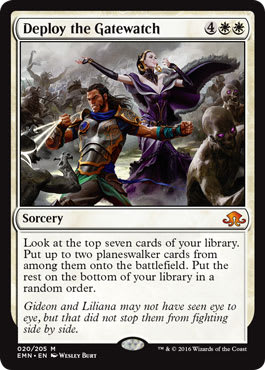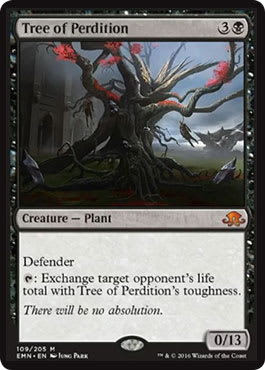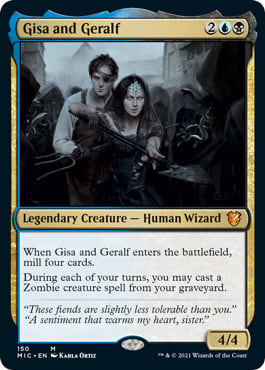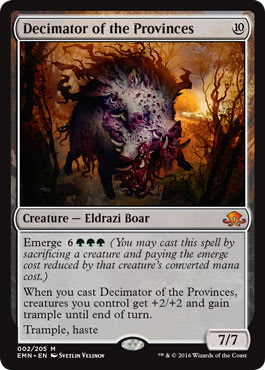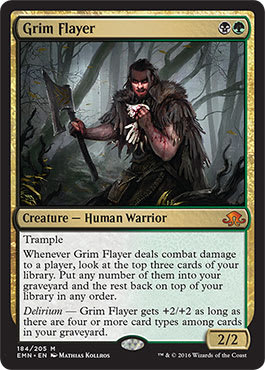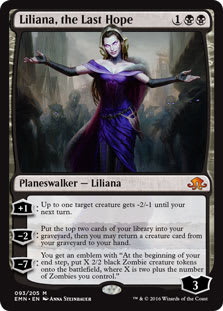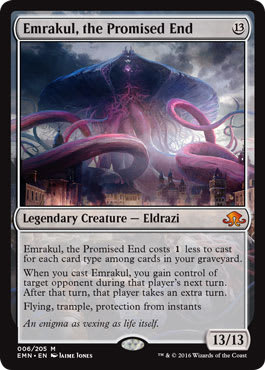Shadows Over Innistrad kicked off the start of the more lovecraftian side of Innistrad under the influence of Emrakul. However, it still retained much of its classic gothic horror side with some of the subtler elements of what you'd expect of lovecraftian horror with minor bodily changes and general states of madness. With Eldritch Moon, though, the gothic elements almost completely melted away, instead leaving a heavy focus on the eldrazi and their presence as physical representations of lovecraftian horrors. This approach may have proved highly contentious among players, but the set's mythics sure weren't!
There's lots of powerful cards that got their start right here and we're going to rank them all! Ready? Let's dive on in!
14. Deploy the Gatewatch
At this point in the game, planeswalkers were still a fairly new commodity. We were starting to hit a strong number by now, but it still felt like we weren't quite there all the way, with few if any getting reprints in supplemental releases. So while doing major planeswalker-focused decks seemed fun, there wasn't quite the level of options to make this worth playing mostly anywhere - even Commander decks. Couple this with the fact that Call the Gatewatch just showed up in the previous set and this ended up being a card few people cared for.
13. Mirrorwing Dragon
The concept behind Mirrorwing Dragon is cool in theory, but difficult to make work well in a meaningful way. There's often not a lot of spells you want to target your own stuff with and if there is, it's likely something small like the meager pump spells in Heroic decks. I'd argue we'd eventually see a better version of this sort of card in Feather, the Redeemed but this version just wasn't good enough to get there.
12. Ulrich of the Krallenhorde // Ulrich, Uncontested Alpha
Players everywhere had been wanting a proper werewolf commander some time now. There were ones for the vampires, zombies, and spirits of Innistrad, but no actual werewolf one. So one finally got printed with Eldritch Moon and almost everyone was underwhelmed by it. Ulrich just didn't pack enough of a punch to make it feel like a good build-around and it left almost everyone wanting more, leading to the eventual printing of Tovolar, Dire Overlord in Midnight Hunt.
11. Nahiri's Wrath
Nahiri's Wrath can be a strong card but to make it work in a meaningful way, you need to discard multiple cards. That's an extremely tall ask that unfortunately only works in a very small subset of decks. This card did find some amount of play in the Standard of its era by being a means to take out multiple large creatures at once, but the cost was often high enough that its presence wasn't particularly large.
10. Tree of Perdition
Oftentimes, Tree of Redemption has been lambasted for being an underwhelming card that's hard to utilize in any meaningful way. So here comes Tree of Perdition, which can be used to sap away opponents' life totals and even possibly combo with the famous Triskaidekaphobia. While it had more novelty than the original, it wouldn't be utilized in any serious way until much later with recent Tree of Perdition combo decks showing up in Pioneer.
9. Mind's Dilation
This card is quite pricey at a full seven mana, but that matters little when you're stealing away your opponents' game plans. While it was far too much mana to see any sort of meaningful competitive play, Mind's Dilation has gone onto be a casual all-star for all the reasons you might expect. Your opponents play anything - even an answer to someone else's play on a turn other than their own - and you'll get to take something off of their deck. It could be super backbreaking or end up being something small-time, but that's what makes it so fun and one of the highest ranking mythics of the set.
8. Tamiyo, Field Researcher
Tamiyo is the first card on this list to boast a fairly solid showing in Standard. The card appeared in numerous iterations of Bant Collected Company decks and then later in Copycat decks once Aether Revolt came around. Unfortunately, most of this play was largely relegated to sideboard slots and infrequently as a one-of in main decks. The three-color combination ended up making her somewhat difficult to cast, and as such players weren't able to make as strong of use of her as they would like. When she hit the board, though, she was phenomenal, but the times where she showed up weren't as many as other key mythics of the set.
7. Gisa and Geralf
While Grimgrin, Corpse-Born may have still been the go-to zombie Commander option for many players, Gisa and Geralf provided an excellent alternate option. It lets you play one zombie from your graveyard each turn, allowing you to keep a big chain of monstrosities hitting your opponents. The problem, though, is that's about all it does, making it somewhat more narrow in applications and a bit better in the 99 than the main headliner of the deck. Still, it creates a very straightforward option for zombie fans to utilize, making it a respectably popular commander to this day.
6. Decimator of the Provinces
When Avacyn Restored first came out, Craterhoof Behemoth proved to be an instant classic. So when Wizards decided to revisit Innistrad in 2016, it's hardly a surprise when they revisited the design. This led to the printing of Decimator of the Provinces, an eldrazi version that you can cast cheaply off of the emerge cost. Craterhoof Behemoth this was not, though, and while it did both have some play and the usual casual love, it lacked the scaling effect that made the original so potent, making it far lesser in most players' eyes.
5. Grim Flayer
Few cards are as mighty of enablers for their decks as Grim Flayer ended up being for Golgari Delirium decks. Not only did it dish out some serious damage, but it let you manipulate your library to find what you want while simultaneously filling up your graveyard to fuel your delirium count. Once you had delirium active, it hit even harder, making for one of the best cards in the Standard format of the era until bannings (and energy) would bring the deck a bit more down to earth.
4. Ishkanah, Grafwidow
Early on during previews, Ishkanah was pretty handily written off by many players. It was essentially seen as little more than cute Commander fodder that acted as a sort of callback to Spider Spawning from the original Innistrad set. Then with a little bit of time, it was showing up heavily in Golgari Delirium decks as one of the main finisher pieces of the archetype. Grim Flayer may fill a similar role in this regard, but Ishkanah also had that easy Commander utility players expected, so it gets a bit of a higher listing here as a result.
3. Liliana, the Last Hope
Liliana, the Last Hope is a great way to look at how Magic players tend to evaluate card power. When this card was first previewed, it was perceived as weak. You can even pull up the Reddit thread from when it was first previewed and see for yourself. Players expected the +1 ability to be too weak to meaningfully act as removal and then she had no way to defend herself. The -2 was perceived as a mediocre way to get creatures back and the low starting loyalty meant it'd be really hard to ever ultimate her.
Turns out the players who evaluated her in this regard were dead wrong. Liliana, the Last Hope became an absolutely dominating force in the Standard of her era. Odds were good you'd often find yourself in situations where you'd end up staring down a Liliana emblem and soon be completely run over by zombies. She even saw plenty of play after rotation, making her a highly in demand card that was sorely in need of a reprint for years until Double Masters 2022 came along. A powerful sleeper and an excellent case study in underrated powerhouses.
2. Gisela, the Broken Blade
With this rank, I'm not exactly talking about Gisela herself with this one. The card is great and definitely saw a lot of competitive play on her own merits. Good stats really made her a force to be reckoned with in terms of competitive play, yet I'd argue Grim Flayer through Liliana all score higher in those regards. So why Gisela? Well it's all about that back side.
Few cards have ever felt as epic as Brisela, Voice of Nightmares. You made this monstrosity utilizing Gisela along with Bruna, the Fading Light and then meld them together. This card combination was hardly ever actually competitively viable, but made for one truly gruesome card that players everyone wanted to try making happen. Given that, Gisela on the whole pulls some serious double duty both on the competitive and casual fronts, making it for one of the best cards in the set by a substantial amount.
1. Emrakul, the Promised End
Everybody was waiting with bated breath for when we'd get the final iteration of the new eldrazi titans and this one sure didn't disappoint. Emrakul, the Promised End was an undisputed force to be reckoned with in its time, coming down with ease thanks to its cost reduction and decks like Aetherworks Marvel. Not only was it massive and hard to deal with, but also Mindslavered an opponent for a turn, allowing you to completely wreck their gameplan. The card was eventually banned in Standard and continues to see fairly strong amounts of play in all formats its legal in, casual and competitive alike, and is one of the best cards of its era.
Paige Smith
Twitter: @TheMaverickGal
Twitch: twitch.tv/themaverickgirl
YouTube: TheMaverickGal
















